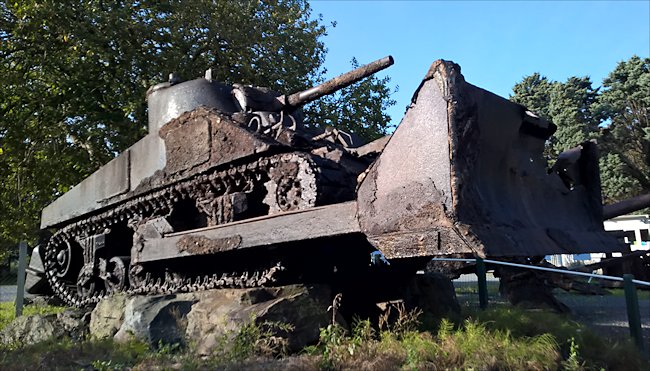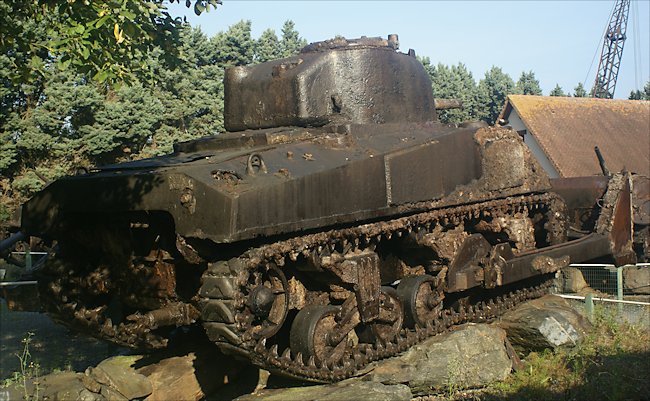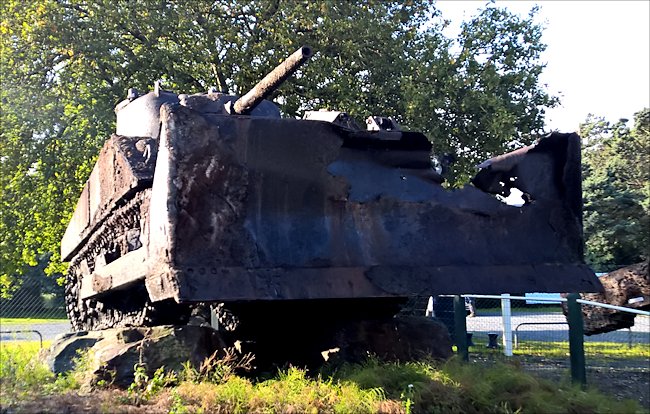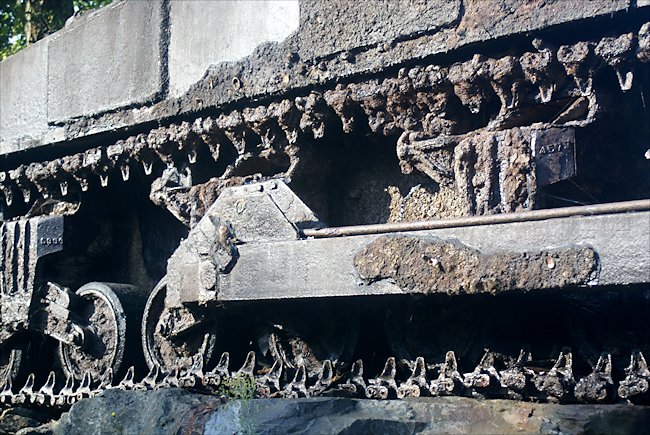Port-en-Bessin M4(75) Sherman Dozer
M4 Sherman tanks were fitted with bulldozer blades to clear beach obstructions as part of the D-Day 6th June 1944 attack on the German held Normandy coast. Some never made the beach as their tank landing craft got hit by a mine and sank.

M4(75) Sherman tanks fitted with a bulldozer blade were landed on the Normandy beaches on D-Day 6th June 1944.
Location
This Sherman Dozer wreck can be seen at the D-Day Underwater Wrecks Museum or in French the Musee des Epaves sous Marine du Debarquement. It is situated on the D6 road from Bayeux to the charming Normandy costal village of Port-en-Bessin-Huppain. Coming from Bayeux it is on the right as you pass the sign for the Chateaux La Cheneviere restaurant.
The complex grounds are screened by a wall of tall evergreen trees. Sticking above the tree tops is a crane and normally three flags; the French tricolour, British Union Jack and American Stars and stripes. Slow your car down as you pass the Chateaux as the museum entrance is very quickly upon you.
The Museum is open every day between 1st June to the 30th September 10am to 1pm closed for lunch and then open again 2pm to 7pm. In May it is only open at the weekend. From 1st October to the end of April it is closed.
Specification
The M4 Sherman was powered by a Continental R975 C1 9 cylinder radial petrol engine that produced 400 hp. It had a maximum road speed of 30 mph (48 km/h). The tank had an operational range of around 120 miles (193 km) before it needed refueling. It needed a five man crew: commander, gunner, loader, driver, co-driver/machine gunner. They were protected by armour that ranged in thickness from 25 mm to 76 mm.
The tank was armed with a standard 75mm gun that could fire high explosive HE artillery rounds as well as armour piercing AP shells. It could penetrate the frontal armour of a Panzer IV tank but not the front armour on the Panther or Tiger tank. To do any damage to their side or rear armour they had to get close. The tank was also armed with two 30-60 Browning M1919A machine guns. One was next to the main gun in the turret whilst the other was in a ball mount in the hull.

This Sherman M4(75) tank had two auxiliary armour plates welded on each side over drivers position and ammo storage locker
Deployment in Normandy 1944
The American army in North Africa realise they needed bulldozers to help make airfields, clear roads, fill in bomb craters, move destroyed vehicles and tanks off roads, and clear rubble. They shipped over a number of different agricultural and construction industry bulldozers. These were an armoured and very dangerous to operate anywhere near the battle front line.
The army came up with the idea of fitting a dozer blade to the front of a tank. Sherman dozers were first used in Italy in April 1944 during the landings at Anzio. In total 1,957 tank bulldozer blades were manufactured during World War II.
Sherman dozers were used during the Battle of Normandy and all the way to Berlin. When tanks and supply vehicles could not cross ditches and anti-tank trenches Sherman dozers were called in to fill those holes. On the D-Day beaches they made roads through the sand dunes so equipment men and tanks could get off the beaches and into the countryside to take objectives. They were also used to construct ramps of earth over the top of anti-tank obstacles and seawalls.

The Sherman Dozer blade was used to clear roads and beach obstructions in Normandy 1944
When the tank was no longer needed to act as a bulldozer the blade arms could be jettisoned and the tank revert to a normal combat M4 Sherman. They were attached to the tank on a track mounted bracket. It was not a major task. It could be done on the battlefield. They were attached to the bogie suspension by bolts. The jack support bracket for the hydraulic jack arm for the blade was fitted to the front towing lugs secured by clamp bolts. The hydraulic arm is then bolted onto the bracket.
Hydraulic pressure for the jack is supplied by an oil pump that is powered by the tank’s engine. An electric power line is run from the tanks front headlight to the pump. An oil supply unit, control unit and pump is mounted directly over the gearbox case inside the tank.

A simple metal plate attached to the track suspension held the dozer blade in place.
To protect the hydraulic setup from small arms fire and armour plating cover is bolted on. The raising and lowering of the blade can be controlled from inside the tank. The blade can also be jettisoned in emergencies from inside the tank. A new wider T18 periscope was fitted to the drivers hatch so he could see better what he was doing during bulldozer operations.
Tanks that were being used during the first waves of the assault on the Normandy beaches were made waterproof. The attachment of a bulldozer blade at the front of the tank did not interfere with the normal running of a waterproof tank. Sherman dozer tanks often the first tanks of the tank landing craft. They deployed their dozer blade to remove beach obstructions while still in the water. This enabled the following tanks to get onto the sand quickly.
Any obstruction that could not be breached was ramped over. Large quantities of earth and sand were built up against the obstruction. Further earth and sand was pushed up the ramp and over the edge to make a ramp on the other side. Sherman dozers were also used to attack machine-gun pillboxes. The bullets bounced off the dozer blade and the sand pushed in front of the blade was used to block up the hole.
D-Day 1944 books

